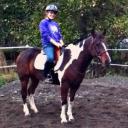Yahoo Answers is shutting down on 4 May 2021 (Eastern Time) and the Yahoo Answers website is now in read-only mode. There will be no changes to other Yahoo properties or services, or your Yahoo account. You can find more information about the Yahoo Answers shutdown and how to download your data on this help page.
Bits...please only answer if you know things about bits?
I know nothing about bits, I am needing a pole/ barrel bit I use a twisted copper snaffle and i hate so I am needing to buy a new bit for my horse no Tom thumb bit, he is neck rein and 4 year old, he dies great in a beetle hackamore but I would prefer a bit for him any ideas of what would work and also what is the different between single broke, double broken and non broken bits and spinning bits I wanna learn about bits
4 Answers
- Live2RideLv 510 years agoFavourite answer
The "broken" pieces are called links, or joints. The different joints on the bit affect the way the mouthpiece communicates with the bars and the tongue. I believe the "spinning" action you're referring to is the roller. Some horses have rollers on their bits to keep them entertained and to encourage them to soften (by playing with the roller with their tongue). Copper mouthpieces naturally encourage the horse to salivate, which also gets them to soften.
Some basic information about bits:
Anything that is set above the mouthpiece is called "purchase." A bit with purchase falls under the category of "gag bits," but not all gag bits are harsh or bad, despite the unappealing name. An example of a mild english gag bit is a boucher: http://www.google.com/imgres?imgurl=http://equinei...
Here are some other examples of gag bits, some harsher than others: http://www.google.com/search?q=gag+bits&tbm=isch&h...
Anything below the mouthpiece is called "leverage." Bits with leverage fall under a group called "curb bits." Western-styled curb bits are most common for western riding (but not always cattle work or gaming). An example of an english curb bit is a kimberwick: http://www.luckypony.com/edu1/images/kimberwick_mo...
Some other curb bits: http://www.google.com/search?q=curb+bits&tbm=isch&...
Bits with leverage always need a curb chain or strap for the leverage action to work.
Bits with a bump in the center (shaped like a little hill, with varying sizes/heights) are called "ports." When engaged, the port affects the bars of the horse's mouth. The higher the port, the harsher the bit.
Bits that do not have any purchase or leverage are called "snaffles." It is commonly assumed that all snaffles are mild bits, because they do not have the purchase or leverage. This is not true. While if used correctly, twisted wire snaffles are not always cruel, they are considerably harsher than a smooth snaffle. Double twisted wires and chain piece snaffles are even stronger. Snaffles can also have different rings on the outsides of the bit which affect the way the bit communicates with the horse. Loose ring snaffles, dee-rings, eggbutts, fixed-rings, etc.
The best way to find out what kinds of bits your horse goes well in is to try a whole bunch on him. Talk to friends who ride or other people at your barn, and ask if you can borrow their bits for a ride or two. It gets too expensive to buy a new bit for every trial run. You can also check out tack sales for cheap deals.
For gaming her horse, my friend uses a Myler Combo bit with a low port. That's one you can try. You can also try all different kinds of snaffles, which are suitable for two-hand riding. Western curbs are really the only kinds of bits you can effectively ride one-handed with.
Source(s): I've learned a lot from my trainer, but I am by no means a bit expert. - RocconisseLv 510 years ago
There's simply a TON of information about bits-- it would be better to get a library book about bits, because there is too much to get into here. HOWEVER:
There is one very simple, very very important rule with bits:
Never try to fix a training problem with hardware.
If your horse isn't responding correctly, 9 times out of 10 the horse needs more training, not different metal in his mouth.
- linda mLv 610 years ago
Hes 4 imo hes too young to be used on speed events since hes still growing,then mixed with a harsh bit as a twisted wire?ouch! Try more groung working and slowing down.I know this nothing to do with bits find a good book on them and choose from there.
- 10 years ago
The full bits, (Ones that aren't cut in half or thirds) i find are better. The broken bits can pinch the horses tongue so naturally, i prefer an unbroken bit. All depends on what works for you and your horse. Try a few out and see how he/she goes with them?
Source(s): experience




